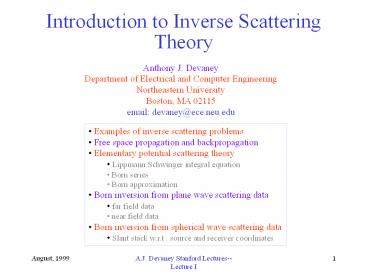Introduction to Inverse Scattering Theory - PowerPoint PPT Presentation
1 / 30
Title:
Introduction to Inverse Scattering Theory
Description:
Introduction to Inverse Scattering Theory Anthony J. Devaney Department of Electrical and Computer Engineering Northeastern University Boston, MA 02115 – PowerPoint PPT presentation
Number of Views:184
Avg rating:3.0/5.0
Title: Introduction to Inverse Scattering Theory
1
Introduction to Inverse Scattering Theory
Anthony J. Devaney Department of Electrical and
Computer Engineering Northeastern
University Boston, MA 02115 email
devaney_at_ece.neu.edu
- Examples of inverse scattering problems
- Free space propagation and backpropagation
- Elementary potential scattering theory
- Lippmann Schwinger integral equation
- Born series
- Born approximation
- Born inversion from plane wave scattering data
- far field data
- near field data
- Born inversion from spherical wave scattering
data - Slant stack w.r.t . source and receiver
coordinates
2
Problems Addressed by Inverse Scattering and DT
Geophysical
x
x
x
x
x
x
x
x
Electromagnetic Acoustic
Off-set VSP/ cross-well tomography GPR surface
imaging induction imaging
x
x
x
x
x
Medical
Ultrasound tomography optical microscopy photon
imaging
Ultrasonic Optical
Industrial
Ultrasound tomography optical microscopy induction
imaging
Electromagnetic Ultrasonic Optical
3
Time-dependent Fields
- Work entirely in frequency domain
- Allows the theory to be applied to dispersive
media problems - Is ideally suited to incorporating LTI filters
to scattered field data - Many applications employ narrow band sources
Causal Fields
Wave equation becomes Helmholtz equation
4
Canonical Inverse Scattering Configuration
Inverse scattering problem Given set of
scattered field measurements
determine object
function
5
Mathematical Structure of Inverse Scattering
Non-linear operator (Lippmann Schwinger equation)
Object function
Scattered field data
Use physics to derive model and linearize mapping
Linear operator (Born approximation)
Form normal equations for least squares solution
Wavefield Backpropagation
Compute pseudo-inverse
Filtered backpropagation algorithm
Successful procedure require coupling of
mathematics physics and signal processing
6
Ingredients of Inverse Scattering Theory
- Forward propagation (solution of boundary value
problems) - Inverse propagation (computing boundary value
from field measurements) - Devising workable scattering models for the
inverse problem - Generating inversion algorithms for approximate
scattering models - Test and evaluation
- Free space propagation and backpropagation
- Elementary potential scattering theory
- Lippmann Schwinger integral equation
- Born series
- Born approximation
- Born inversion from plane wave scattering data
- far field data
- near field data
- Born inversion from spherical wave scattering
data - Slant stack w.r.t . source and receiver
coordinates
7
Rayleigh Sommerfeld Formula
Suppress frequency dependence
S
Boundary Conditions
z
Sommerfeld Radiation Condition in r.h.s.
Dirichlet or Neumann on bounding surface S
Plane surface
8
Angular Spectrum Expansion
Weyl Expansion
Plane Wave Expansion
9
Angular Spectrum Representation of Free Fields
Rayleigh Sommerfeld Formula
10
Propagation in Fourier Space
Homogeneous waves Evanescent waves
Free space propagation (z1gt z0) corresponds to
low pass filtering of the field
data Backpropagation (z1lt z0) requires high pass
filtering and is unstable (not well posed)
11
Backpropagation of Bandlimited Fields Using A.S.E.
Propagation
z
Backpropagation
z0
zmin
Boundary value of field (or of normal derivative)
on any plane zz0 ? zmin uniquely determines
field throughout half-space z ? zmin
12
Backpropagation Using Conjugate Green Function
Forward propagationboundary value
problem Backpropagationinverse problem
Boundary Conditions
S
S1
Incoming Wave Condition in l.h.s.
Dirichlet or Neumann on bounding surface S1
Plane surface
AJD, Inverse Problems 2, p161 (1986)
13
Approximation Equivalence of Two Forms of
Backpropagation
Homogeneous waves Evanescent waves
14
Potential Scattering Theory
Lippmann Schwinger Equation
15
Born Series
Lippmann Schwinger Equation
- Linear mapping between incident and scattered
field - Non-linear mapping between object profile and
scattered field
Object function
16
Scattering Amplitude
Non-linear functional of O
Induced Source
Linear functional of ?
Boundary value of the spatial Fourier transform
of the induced source on a sphere of radius k
(Ewald sphere)
Inverse Source Problem Estimate source Inverse
Scattering Problem Estimate object profile
17
Non-uniqueness--Non-radiating Sources
Inverse source problem does not possess a unique
solution Inverse scattering problem for a single
experiment does not possess a unique solution
Use multiple experiments to exclude NR sources
Difficulty Each induced source depends on the
(unknown) internal field--non-linear character of
problem
18
Born Approximation
Linear functional of O
Boundary value of the spatial Fourier transform
of the object function on a set of spheres of
radius k (Ewald spheres)
Generalized Projection-Slice Theorem in DT
19
Born Inverse Scattering
Ewald Spheres
k
2k
Ewald Sphere
Limiting Ewald Sphere
20
Using Multiple Frequencies
Back scatter data
Multiple frequencies effective for
backscatter but ineffective for forward scatter
21
Born Inversion for Fixed Frequency
Problem How to generate inversion from Fourier
data on spherical surfaces
Inversion Algorithms Fourier interpolation
(classical X-ray crystallography) Filtered
backpropagation (diffraction tomography)
A.J.D. Opts Letts, 7, p.111 (1982)
Filtering of data followed by backpropagation
Filtered Backpropagation Algorithm
22
Near Field Data
Weyl Expansion
23
Spherical Incident Waves
Lippmann Schwinger Equation
Double slant-stack
24
Frequency Domain Slant Stacking
Determine the plane wave response from the point
source response
Single slant-stack operation
25
Slant-stacking in Free-Space
Transform a set of spherical waves into a plane
wave
Rayleigh Sommerfeld Formula
Fourier transform w.r.t. source points
26
Slant-stacking Scattered Field Data
Stack w.r.t. source coordinates
27
Born Inversion from Stacked Data
Use either far field data (scattering amplitude)
or near field data
Far field data
Near field data
Near field data generated using double slant stack
28
Slant stack w.r.t. Receiver Coordinates
Slant stack w.r.t. source coordinates
Slant stack w.r.t. receiver coordinates
z
29
Born Inversion from Double Stacked Data
Fourier transform w.r.t source and receiver
coordinates Use Fourier interpolation or
filtered backpropagation to generate
reconstruction
30
Next Lecture
Diffraction tomographyRe-packaged inverse
scattering theory
Key ingredients of Diffraction
Tomography (DT) Employs improved weak scattering
model (Rytov approximation) Is more appropriate
to geophysical inverse problems Has formal
mathematical structure completely analogous to
conventional tomography (CT) Inversion algorithms
analogous to those of CT Reconstruction
algorithms also apply to the Born scattering
model of inverse scattering theory

